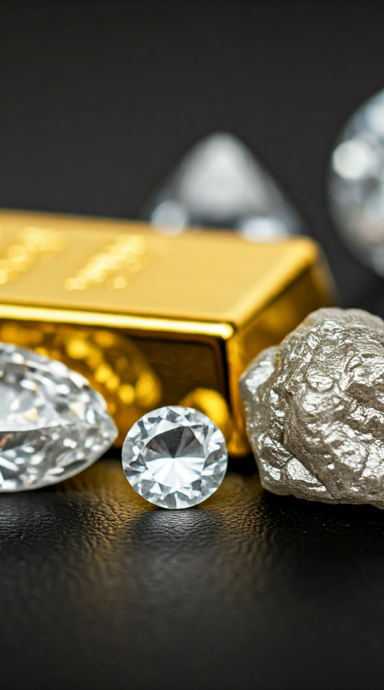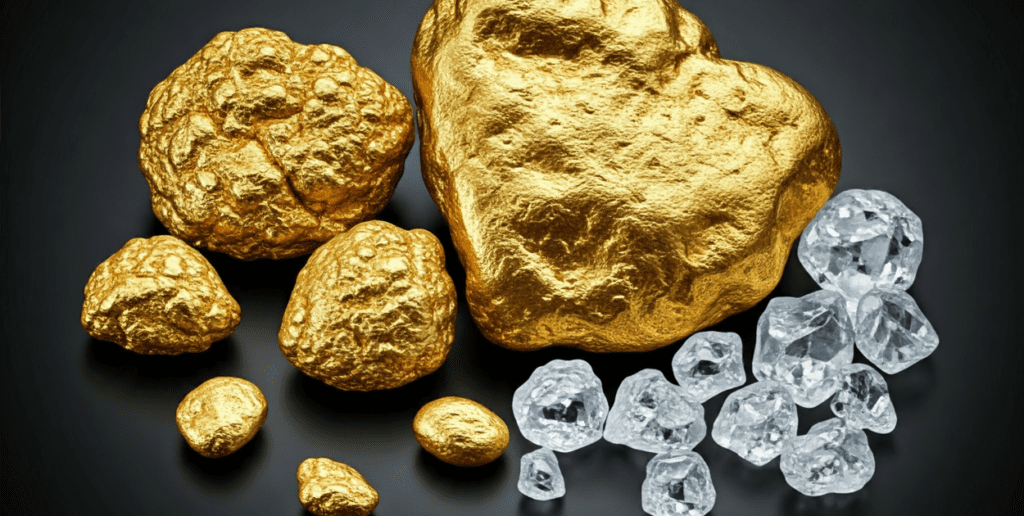Gold and diamonds have long been symbols of wealth, luxury, and status, but when it comes to determining which is more valuable, the answer isn’t as straightforward as you might think. Both gold and diamonds hold significant value, but they are measured and valued in different ways depending on factors like rarity, demand, and intrinsic worth. In this blog, we’ll compare the two, helping you understand the key differences in their value, and why you might choose one over the other as an investment or purchase.
The Value of Gold
Gold has been a universally recognized store of value for thousands of years. Whether in the form of coins, bars, or jewelry, gold is prized for its beauty and its ability to retain value over time. Here’s why gold is considered valuable:
1. Intrinsic Value
Gold has intrinsic value, meaning it’s valuable in itself due to its properties. It doesn’t tarnish, it’s highly conductive, and it’s relatively rare. Gold is also used in various industries, from electronics to dentistry, giving it practical uses beyond just jewelry or coins.
2. Tangible Asset
Gold is a physical, tangible asset that you can hold in your hand, unlike stocks or bonds, which are intangible. For many, the ability to physically possess their wealth in the form of gold is a significant factor when deciding to invest.


3. Global Recognition
Gold’s value is recognized globally. No matter where you are in the world, gold has a set value based on weight and purity. It’s also highly liquid, meaning it can easily be bought or sold.
4. Hedge Against Inflation
One of the biggest reasons people invest in gold is its reputation as a hedge against inflation and economic uncertainty. During times of financial instability, gold prices tend to rise as people flock to the safety of this precious metal.
How Gold is Valued:
Gold is measured by its purity (karats) and weight (usually in troy ounces). The price of gold fluctuates based on the global market, but it remains relatively stable over long periods. Factors that affect the value of gold include:
- Market Demand: The higher the demand for gold, especially during times of economic stress, the more its price increases.
- Purity: 24K gold is pure gold, while lower-karat gold contains alloys, which decrease its value.
- Weight: The more gold you have by weight, the higher its value.
The Value of Diamonds
Diamonds, on the other hand, are often seen as a symbol of luxury and romance. Unlike gold, diamonds are valued more subjectively, based on a combination of characteristics, including size, clarity, color, and cut. Here’s why diamonds are considered valuable:
1. Rarity
Diamonds are rare, particularly high-quality diamonds with no inclusions (imperfections) or color tints. The rarer the diamond, the higher its value. However, while diamonds are rare in nature, they are widely available in the market due to large mining operations.
2. Emotional and Aesthetic Value
Much of a diamond’s value is based on its emotional significance. Diamonds are often associated with engagement rings, luxury jewelry, and special life events. This emotional attachment increases demand and helps maintain high prices.


3. Market Control
The diamond market is heavily influenced by large corporations, most notably De Beers, which has historically controlled the supply of diamonds to keep prices high. While there are natural diamonds, synthetic diamonds are also becoming more common, offering alternatives that are visually identical to the natural ones but less expensive.
How Diamonds are Valued:
Diamonds are valued based on the Four Cs: carat, cut, color, and clarity. Here’s what that means:
- Carat: The size of the diamond. Larger diamonds are generally more valuable, but their value increases exponentially with size.
- Cut: How well the diamond has been cut. A well-cut diamond will reflect light better and appear more brilliant.
- Color: Diamonds are graded on a scale from D (colorless) to Z (light color). The less color, the more valuable the diamond.
- Clarity: The fewer inclusions or imperfections a diamond has, the higher its clarity and, therefore, its value.
Comparing Gold and Diamonds
1. Investment Potential
Gold is generally considered a better investment asset than diamonds. Its value is tied to the global market, and it has historically been a safe haven during economic downturns. Gold is also highly liquid, meaning you can sell it easily at its current market price.
Diamonds, while valuable, are not as easy to liquidate at full market value. The resale market for diamonds is often limited, and their value is heavily influenced by subjective factors, such as the Four Cs, making them more volatile as an investment.
2. Price Stability
Gold prices fluctuate based on supply and demand, but overall, it’s considered a stable asset. The price of gold tends to rise over time, particularly during periods of inflation or economic crisis.
Diamonds, on the other hand, don’t have the same historical price stability. Their value is more susceptible to market manipulation, fashion trends, and the availability of synthetic diamonds. Additionally, the resale value of diamonds is often lower than the original purchase price, making them a less reliable investment compared to gold.


3. Rarity and Supply
Gold is rare, but it’s mined consistently and is available in large quantities. Its value is more tied to market conditions and the demand for physical gold.
Diamonds are also rare, but the supply is tightly controlled by a few large corporations, which can influence market prices by controlling how many diamonds are available for sale at any given time. This artificial scarcity can drive up prices, but it also makes the diamond market less predictable.
4. Emotional vs. Practical Value
Diamonds often carry more emotional value, particularly in jewelry. They are associated with important life events, such as engagements and weddings, and their brilliance and beauty make them highly desirable for aesthetic reasons.
Gold, on the other hand, is valued more for its practical uses, whether as an investment, a commodity in industry, or as a form of currency. While it’s still beautiful in jewelry, its value is not driven by emotional factors to the same extent as diamonds.
Conclusion: Which Is More Valuable?
Ultimately, whether gold or diamonds are more valuable depends on the context. If you’re looking for a stable, liquid investment that can hedge against inflation and economic uncertainty, gold is the clear winner. Its value is tied to the global market, making it a safer and more predictable investment.
On the other hand, diamonds carry more emotional and aesthetic value, especially for those looking for jewelry that symbolizes special occasions. However, diamonds are not typically a good investment asset due to their fluctuating resale value and subjective pricing.
If you’re considering a purchase, think about your goals: Are you investing for the future, or are you seeking something with sentimental value? Your answer will determine whether gold or diamonds are the better choice for you.
